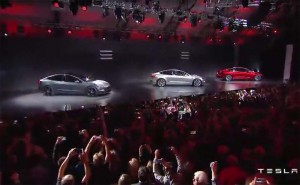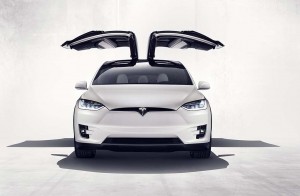Tesla Motors founder and CEO Elon Musk is nothing if not ambitious, based on the expansive new “Master Plan, Part Deux” the executive released late Wednesday, a week later than originally planned.
The blog posting from Musk calls for the California company to flesh out its line-up with an assortment of new battery-electric vehicles, including a “new kind of pickup truck,” as well as an SUV smaller than the current Model X. But it also appears to envision Tesla as a supplier of a broad range of green technology solutions, a move that is based on its planned acquisition of solar panel company SolarCity.
The theme of the Master Plan is “sustainability,” said Musk, in an almost apocalyptic blog post warning of dire consequences if the world doesn’t get off its oil fix.
“By definition, we must at some point achieve a sustainable energy economy or we will run out of fossil fuels to burn and civilization will collapse,” he wrote. “Given that we must get off fossil fuels anyway and that virtually all scientists agree that dramatically increasing atmospheric and oceanic carbon levels is insane, the faster we achieve sustainability, the better.”
(Hyundai working on 250-mile EV. Click Here for the story.)
Musk’s intensity, as much as the products he has shepherded into production, has developed a cult-like following for Tesla Motors. But the automaker is now at a critical juncture. While sales have grown over the last few years, the Models S and X are nonetheless high-priced niche products with limited potential. The real test will come with the launch of the Model 3 late next year targeting, for the first time, a mainstream audience.
It has been argued that, despite the initial reception for the Model 3 – with Tesla claiming about 400,000 advance reservations – the carmaker actually misses the mark, bringing out a sedan at a time when Americans by the millions are abandoning passenger cars for light trucks. So, the addition of a compact SUV in the new Master Plan appears aimed at rectifying that problem.
As for adding a pickup truck, Tesla loyalists are likely to realize this isn’t the first time CEO Musk has raised the idea. He has been discussing that possibility, in fact, for at least three years – though some initially thought it was a ruse meant to draw Texas into a bidding war for the carmaker’s Gigafactory battery plant.
Exactly what Musk means by “a new kind of pickup truck” is far from clear. Honda made a similarly bold statement when it launched its first-generation Ridgeline which was based on a car-like platform rather than the conventional body-on-frame architecture rivals use. Despite the initial buzz, the first Ridgeline failed. Honda stuck with the crossover-style platform for the new 2017 model, but has adopted a more conventional “truck-truck” design.
Truck buyers value durability and capability, even those who use their pickups for little more than getting mulch from the local garden supply store. So, how much room there is for something truly different is far from certain.
Along with the pickup and SUV, the Tesla Master Plan calls for the addition of a commercial truck dubbed the Tesla Semi, as well as a new public transit bus. Energy efficiency in both sectors would be well received, within the constraints of their heavy-duty demands. But there are already competitors targeting commercial battery-powered trucks and buses.
Tesla may have been launched as an electric car company but it has been broadening its reach, notably with the addition of the Powerwall battery backup system launched last year.
Now, it appears, Musk wants to see the company become even more of a one-stop shop for all your green energy needs. That includes the ability to buy an all-in-one solar roof, apparently, that would take advantage of Tesla’s proposed acquisition of Solar City.
That move has generated plenty of controversy, in part due to the questionable synergies of the two companies, but also due to a seeming conflict of interest. A close Musk relative runs SolarCity and the Tesla CEO himself serves as the solar panel company’s chairman.
A fair section of Musk’s Master Plan takes a defensive tone. There is a strong defense laid out for the Solar City deal, for one thing. Pointing to the breadth of the Master Plan, Musk wrote that, “We can’t do this well if Tesla and SolarCity are different companies, which is why we need to combine and break down the barriers inherent to being separate companies.”
The blog post also downplays the intense criticism that has arisen in recent weeks, ever since Tesla belatedly revealed the fatal crash of a Model S running in semi-autonomous Autopilot mode in Florida on May 9. In fact, the brouhaha, and news of two more crashes and several federal probes – one by the National Highway Traffic Safety Administration, the other by the National Transportation Safety Board – may explain why the release of the new Master Plan comes a week later than Musk originally said.
“When used correctly, (Autopilot) is already significantly safer than a person driving by themselves,” he wrote in the new blog post.
If anything, Musk made it clear he is committed to fully autonomous driving, though he suggested it will need at least five more years of testing. But eventually, he made clear, Tesla plans to make all of its vehicles, commercial and retail, self-driving.
(Carmakers can’t sacrifice safety in rush to autonomous driving, warns Transportation Sec. Foxx. Click Here for the latest.)
The company even appears ready to get into the ride-sharing game – in part by taking advantage of autonomous technology. Tesla appears to be interested in taking on giants like Uber and Lyft, and will tap its owners to help field a large fleet of vehicles.
“You will also be able to add your car to the Tesla shared fleet just by tapping a button on the Tesla phone app and have it generate income for you while you’re at work or on vacation,” he explained.
As broad as the Master Plan appears to be, the initial response is running from wildly upbeat to skeptical.
While a broad outline, “The document is relatively short on details,” cautioned Deutsche Bank analyst Rod Lache, and though it discusses new products and ventures, he added, it does not lay out specific financial targets.
That was echoed by Barclay Capital’s Brian Johnson. “The plan is like before – or like much of what Tesla does – long on exciting visions of the future and short on financial details,” the analyst wrote in a note to clients.
Tesla’s planned takeover of Solar City still faces a number of hurdles. Its Autopilot system is under close scrutiny, as well. It had to raise about $2 billion through a new stock offering in May just to finish development of the Model 3.
How and when the rest of the new Master Plan will come together remains to be seen.
(Tesla plans to improve Autopilot, Musk says. Click Here for more.)




Has anyone engineered how we reuse/dispose of the Li-Ion batteries when we’re making these in the millions?